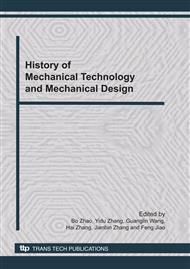p.135
p.139
p.143
p.147
p.151
p.156
p.160
p.166
p.170
3-D Optimization of Self-Balanced Torsion Bar Diameter and its Fillet Radius by FEM
Abstract:
The torsion bar system model of a 150-ton convertor tilting mechanism was made by using APDL language of the finite element software ANSYS.And the diameter of the torsion bar and the fillet radius were optimized based on the above analysis by using optimal module.A new 150-ton convertor was developed by the optimal results and has been in good performance since 2006.The results show that the optimal structure of torsion bar was more economic and reasonable than the traditional structure.Optimization scheme can all be given access to safe,economical and reliable design results and ensure the converter performance.Moreover, this method provides three-dimensional, multi-touch, irregular structure with a valuable experience and a new idea and can be extended to the design of heavy products.
Info:
Periodical:
Pages:
151-155
Citation:
Online since:
November 2010
Authors:
Price:
Сopyright:
© 2011 Trans Tech Publications Ltd. All Rights Reserved
Share:
Citation:


